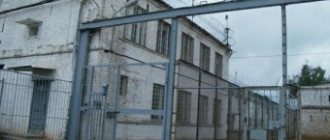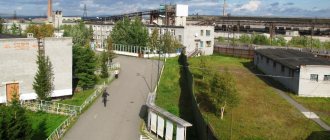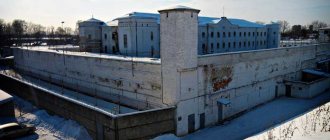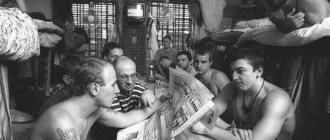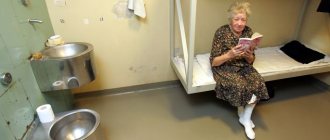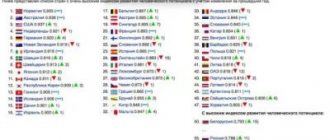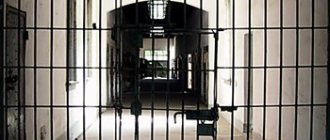On the territory of the Russian Federation, as in any other state, there is a strict system associated with the punishment of criminals. According to the law, those sentenced are placed in prisons and colonies, which in our country come in several varieties.
The lion's share of prisoners end up in maximum security colonies in Russia. The legislation defines the types of prison premises within the framework of the Penitentiary Commission of the Russian Federation. The conditions of detention in them are reflected in Article 123.
Dear readers! Our articles talk about typical ways to resolve legal issues, but each case is unique.
If you want to find out how to solve your particular problem, please use the online consultant form on the right or call
What it is
A special regime correctional colony is a place where the most dangerous criminals are sent.
These include:
- Men who are sentenced to life imprisonment.
- Men whose crimes constitute a particularly dangerous recidivism.
They serve their sentences in conditions of almost complete isolation from the outside world. Such punishment should make offenders aware of their behavior and motivate them to seek legitimate means to solve problems.
Free legal consultation
+8 800 100-61-94
Women are not allowed into these establishments. The court sentences them to a penal colony or a general regime penal colony, depending on the severity of the criminal act committed. The law does not provide for the imposition of life sentences on females.
Attention! Those who received life sentences are the most dangerous to society. To eliminate their possible influence on less dangerous criminals, both are kept separately from each other.
Echoes of bloody showdowns
Criminal authority Stanislav Tishchenko. Photo: Website www.mzk1.ru
Each of those serving life sentences in Snowflake has a very dark past. For example, one of the oldest prisoners of IK-6, 75-year-old Stanislav Tishchenko, was previously imprisoned in the Black Dolphin colony in the Orenburg region. Tishchenko was there with his son Igor, and they ended up behind bars because of a gang war that occurred in 1996.
Then Igor Tishchenko opened fire at a kebab shop near Norilskaya Street in Moscow, and his father Stanislav threw a grenade at his opponents. Among those killed in the incident was thief in law Nikolai Akbashev, known in criminal circles as Akbashenok. For the attack in a kebab shop, father and son Tishchenko received life sentences.
Stanislav Tishchenko’s neighbor in “Snezhinka” Alexander Lozhkin is a participant in the most mass murder in the Middle Urals. It was committed in one of the saunas of Nizhny Tagil on the night of February 8, 1997: a party was being held there on the occasion of the birthday of one of the vacationers. As usual, there was some alcohol involved, and at some point a quarrel broke out in the sauna. During the ceremony, the birthday boy asked four guests to leave, one of whom was Lozhkin.
He was offended by such a disrespectful gesture, took out a gas pistol, which he himself converted into a combat pistol, and began to shoot. The three remaining guests, who were asked to leave the sauna, attacked their opponents with knives. As a result, eight people died, six of whom were killed by Lozhkin. In 2001, he received a life sentence, which he served in the Black Golden Eagle before Snezhinka.
Conditions of stay
The convicted person is subject to strict requirements that he must take into account. Neglect or improper performance of duties may result in disciplinary action. In some cases, the offender can be sent to prison.
One of the indispensable conditions for maintaining order is that each convicted person performs labor duties. The exceptions are:
- Men and women who have reached retirement age.
- Persons with a confirmed disability of group I or II.
These categories of citizens have the right to choose whether to engage in labor activity or not. Refusal to work for those who do not have such benefits is perceived by the management of the IC as a violation of the routine.
For this, refuseniks are subject to penalties, including:
- Fine up to 200 rubles;
- Rebuke;
- Placing the offender in a punishment cell. The punishment can last up to 15 days.
- Transfer from hostel to cell.
Even a single refusal to work or willful termination of work can be regarded as a malicious violation of the established procedure. Then even more harsh conditions are created for the prisoner. His freedom of movement is limited, the number of visits and shipments received is reduced.
Under no circumstances can appointments be canceled entirely. The right of a criminal to meet with close relatives and other persons is enshrined in the Criminal Executive Code of the Russian Federation. Meetings can be:
- Short-term – for 4 hours, under the supervision of a correctional officer.
- Long-term – living with a relative or other person for 3-5 days. Permitted only on the territory of the penitentiary institution.
Criminals held in a special regime colony are not allowed to leave its boundaries. Even extraordinary circumstances - the death or serious illness of a relative, or natural disasters - are not an exception. Meetings outside the walls of the institution are also impossible.
The number of meetings between a convicted person and a lawyer in a special regime colony is not limited. But each date cannot last more than 4 hours.
It is also useful to read: What is a colony-settlement
Description of castes (suits)
There are only 4 main castes: “thieves”, “men”, “goats” and “roosters”.
- The thieves have the greatest authority and power. They establish the unwritten rules of conduct in the prison and ensure that order is maintained according to these rules. Resolving a dispute between prisoners is also the job of the thieves. The punishment of the guilty is in their hands.
- The neutral group is men. As a rule, such people do everything to get free as soon as possible and not end up in such places again. Men do not have the right to vote, they cannot participate in showdowns, nor can they serve the authorities.
- Goats. Considered a dishonorable caste. This includes those who, of their own free will, began to cooperate with the administration of the place of deprivation of liberty. The caste of goats includes those prisoners who hold any prison position - (librarian, caretaker). Goats have no rights in the criminal world, but you can greet and communicate with those who belong to this caste.
- The lowest caste is the “roosters”. Not only do they not communicate with them, even simply touching them is considered shameful. As a rule, their sleeping place is located separately, closer to the exit. They have separate dishes and cutlery. The closest distance that “roosters” can approach other prisoners is 3 steps. They are given the dirtiest job - cleaning toilets.
While every effort should be made to avoid contact with a rooster, “eating it” (when forced sexual intercourse is performed on such a convicted person) is not considered defiling.
What caste can pedophiles be in and how do they “sit”?
Child rapists are not forgiven and are not justified in any way. In prison, a pedophile is “lowered” to the “rooster” caste. But since pedophiles are considered the most unnecessary people, in the zone they do everything to prevent them from leaving alive. Moreover, it will not necessarily be murder. There are cases when a pedophile is overloaded with work to such an extent that he simply cannot stand it physically.
From the very beginning of its creation to the present day, the prison has been the main type of penitentiary institution throughout the world. Over the period of its existence, this type of institution has become a small world, with its own laws, values and concepts.
For particularly serious crimes, a person is sentenced to life imprisonment.
Such prisoners cannot be held in colonies together with other convicts.
Therefore, special regime colonies are provided for them. They differ in their detention regime and are located geographically in remote corners of Russia, from where it is almost impossible to escape.
Read about the most brutal prisons in Russia in our article.
Conditions of serving in penal colony
Staying in a special regime correctional facility is possible under several conditions. One changes to another depending on the behavior of the prisoner and his attitude to work. Participation in cultural events has a positive impact on characteristics.
Strict
They are assigned to those who are recognized as persistent violators. The second category includes persons who intentionally committed a crime while already serving a sentence. Immediately after entering a special regime colony, they are placed in strict conditions.
It means that:
- Instead of a bed in a dormitory, they are given a place in a cell-type room.
- The limit of funds that a prisoner can spend on food and essential goods is 6,600 rubles per month.
- The number of dates per year is limited to 2 short-term and 1 long-term.
- During the year you can receive: 1 parcel and 1 parcel.
- Movement around the colony has been reduced to nothing. Only short walks lasting an hour and a half are allowed. Model behavior is rewarded with a 3-hour walk.
If, within 12 months from the date of placement of the offender in strict conditions, he shows signs of improvement, he can be transferred to normal conditions. Improved behavior should be expressed in strict adherence to rules and a conscientious attitude to work. The latter applies only to working citizens.
Reference! To be transferred to better conditions, the presence of all 3 components is required: staying in the worst conditions for a set time, exemplary behavior, diligent performance of work.
Normal conditions
Newly arrived convicts who do not qualify for other conditions are accommodated here. Violators of light regime or those who have reformed from strict regime are also transferred here.
They have the following rights:
- Spend up to 7,200 rubles monthly on food and essential goods.
- Meet with visitors 4 times a year (2 dates of each type).
- During the year, accept 6 shipments (3 of each type).
Citizens who have broken the law live in a shared dormitory with other prisoners. Persons who have a positive characterization from the administration of the penal colony can count on improved conditions of detention.
Lighter conditions of special regime
The most favorable conditions for serving a sentence in a special regime colony are light. Well-proven convicts who have embarked on the path of correction are transferred to them. As in normal conditions, here the criminals live in a dormitory. An incentive measure is to expand the range of available rights.
They have the opportunity:
- Spend up to 7,800 rubles per month.
- Within 12 months, see relatives or other persons:
- On a short-term date – 3 times.
- Long term – 3 times.
- Receive 8 items (4 of each type).
If a person is found to be a persistent offender, he is sent to strict or regular detention. To return back, you will need to behave exemplary and conscientiously treat the assigned work responsibilities throughout the year.
Particularly strict
The Criminal Executive Code does not include particularly strict conditions in the classification of conditions in a special regime colony. However, formally they include the situation of those serving life sentences. It is significantly worse than the situation of other offenders held in this institution.
Among the differences:
- The life of a criminal is spent in a cell - single or for 2 people.
- Work is only allowed while in a cell.
- All life-sentenced prisoners are subject to strict conditions upon entering the colony. Personal characteristics and circumstances of the crime do not matter.
- Transfer to normal conditions is possible only after 10 years in strict conditions.
- From a regular regime, a person can be transferred to a light regime after 10 years of being in the first regime.
- If the offender is guilty and finds himself in worse conditions, he will again have to spend 10 years in them.
- The duration of walks varies depending on conditions:
- Strict – 1.5 hours.
- Regular – 2 hours.
- Lightweight – 2.5 hours.
Important! If the offender is of good behavior, half an hour is added to the usual duration of the walk.
The number of available dates, packages and possible expenses does not differ from other conditions.
What is a special regime?
The special regime in the colonies differs significantly from the general and strict regime. It can be of three types :
- lightweight;
- ordinary;
- strict.
They differ in:
- The amount of money prisoners can spend on personal needs.
- The number and duration of dates, the size of parcels.
For the first 10 years, convicts are kept under strict conditions, then they are transferred to ordinary conditions.
If the convicted person does not violate the regime, does not commit crimes, that is, behaves according to the rules, then he can qualify for a light regime.
It gives the right to spend 60% of the money from the account on personal needs, receive 4 parcels, parcels and deliveries annually, 4 short and 4 long dates throughout the year.
However, most of the convicts were disowned by all their relatives, so they receive neither parcels nor visits.
Under strict conditions, the offender is kept in solitary confinement. He is entitled to 2 short visits, which take place in a room with glass through which the convict communicates with relatives. You can also send just one transmission.
Cameras
Criminals are in cells of 2-3 people or alone . Those who pose a danger to fellow inmates and are prone to escape and attack the convoy live alone.
There are signs next to the bed and outside the cell describing the atrocities the prisoner has committed. This is done to ensure that the staff does not develop sympathy for the criminal.
Assignment to cells in the zone is based on psychological compatibility. Usually pedophiles and maniacs sit alone, since no one can withstand such proximity for more than 2-3 days.
The cells contain metal beds, chairs and tables bolted to the floor (see photo). During the day, it is forbidden to sit, much less lie on the bed ; you can only sit on chairs.
The convicts sleep, facing the door, in the light. You can’t turn your back to the wall or cover your head with a blanket. If one person violates the rules, then everyone who sits in that cell is responsible.
Also, people are required to wear only prison uniform ; wearing anything else is strictly prohibited.
The windows in the rooms are located high, so people cannot see daylight. They are under 24-hour video surveillance.
Searches are carried out every 15 minutes , for this purpose the prisoner puts his hands through the window to put on handcuffs. Then he is taken out into the corridor in a bent position. For each convict there are 3 employees with a dog.
Walking is carried out in a special small room , where air enters only from above. Movement around the colony is only possible with a blindfold, accompanied by guards with dogs. Some establishments are allowed to work.
Criminals work in separate cells of 1-2 people.
There they can paint pictures, carve wood, sew mittens, etc.
For this they are entitled to a salary , which almost entirely goes towards compensating the victims.
No cultural events are held . You are allowed to watch movies occasionally for special merits. Any communication between inmates is also excluded. Self-study is possible, but you cannot officially enter educational institutions.
The colonies have libraries with predominantly religious literature and chapels. The priest regularly visits convicts with sermons. Almost 90% of criminals begin to believe in God.
Daily regime
The morning of prisoners begins at 6.00 . Half an hour is given to make the bed and toilet. Then breakfast time begins. It is served directly into the cells through the window. After breakfast, some go to work, the rest stay in their cells. They can read books, listen to the radio.
Lunch starts at 12 . Before this, the cells are searched and prisoners are asked for complaints. After eating, you can also write letters and read. Walk for about 45 minutes in a special room.
At 7 o'clock there is dinner.
Lights out at 22:00 , after which movement in the cells is prohibited, with the exception of visiting the toilet.
Once a week, criminals are taken to the shower.
They are led to the shower room in handcuffs, then through the window the guard removes the handcuffs. Washing usually lasts 45 minutes . When necessary, a barber comes to cut the prisoners' hair.
If any health problems occur, the person is examined by a prison doctor . Every year, prisoners undergo fluorography and, if necessary, visit a dentist.
If a criminal is diagnosed with tuberculosis, HIV or hepatitis, they receive free treatment from the state. Every year, up to 900 thousand rubles are spent on 1 such patient.
Examination by a doctor is also carried out through the bars. If necessary, a course of treatment with tablets or droppers is prescribed. If there is a serious threat to the health of the patient, he is transferred to the medical unit .
When a prisoner dies, his relatives are notified. If they don't claim his body within 10 days, he is buried in a cemetery. Subsequently, relatives can carry out reburial.
Usually people live in special regime for 7-10 years, but there are those who stay there much longer. Some cannot stand it and commit suicide.
How is it different from general mode IR?
A general regime colony is a closed institution to which less dangerous male offenders are sent who have committed:
- Acts classified as crimes of minor or medium gravity.
- Serious crimes.
The individuals are united by the fact that they have never previously served a sentence within the walls of a correctional facility. Due to the fact that the degree of public danger of the crimes they commit is lower, the deformation of the personality of such violators is not so significant. Therefore, they are kept in less harsh conditions.
The most lenient rules are set by:
- Citizens who are imprisoned are not limited in spending; they live in dormitories.
- Has the right to meet with visitors 12 times a year (6 dates of each type).
- Can receive 24 pieces of mail (12 of each type).
The second difference between the general and special regime is the conviction of women. The law does not allow a female person to serve her sentence in a special regime colony.
Convicts in a general regime penal colony have additional rights. If there are special conditions, they can travel outside the penitentiary institution. Those with a life sentence, convicted of a particularly dangerous recidivism, are deprived of this opportunity.
The most famous special regime institutions in Russia
All life-long zones in Russia have a long history. Over the years, some of them have acquired myths and their own special conditions for keeping prisoners. “Black Dolphin”, “Polar Owl”, “White Swan” are the most severe among the colonies of this type.
"White Swan"
Perhaps every resident of the country has heard about the Solikamsk special regime colony. This “zone” has always been famous for its strict rules, but few people know that before “White Swan” was not particularly different from other Soviet prisons. Its first inhabitants in 1938 were political prisoners, mostly priests. And only in 1955, all the church ministers were transferred to Mordovia, and “thieves in law” were brought to the colony for “re-education.” Under powerful psychological and physical pressure from the inmates who collaborated with the guards, more than 100 criminal authorities here abandoned the thieves’ “crown.”
Colony "White Swan" in the city of Solikamsk In 1999, the institution was repurposed as a colony for life-sentenced prisoners. Interestingly, many experts in the criminal subculture still disagree about the name. Some believe that the prison became the “White Swan” because of the posture of prisoners in which they usually move along the corridors: their torsos are in an inclined position, and their hands are handcuffed behind their backs raised up (FSIN employees call this the “ku pose”). According to others, the colony was named so because of the large number of small sculptures of swans located in the courtyard. Here, at different times, the legendary leader of the Soviet thieves' world, Vasily Babushkin, nicknamed Vasya Brilliant, as well as the famous terrorist Salman Raduev, died.
Salman Raduev
"Black Dolphin"
One of the oldest and largest Russian colonies was founded under Catherine the Great in the 18th century. The prison in the Sol-Iletsk fortress was built for the participants of the Pugachev rebellion. Since 2000, serial killers, maniacs and rapists sentenced to life imprisonment have been held here. All residents are under 24-hour video surveillance. Mostly there are two or three people in the cells, but there are also “solitaries” for those who are especially dangerous. The prisoners live according to a harsh routine: they sleep in bright light and only with their heads towards the door, without covering their faces with a blanket. Throughout the day, prisoners are prohibited from sitting on the bed, and if an administrative officer sees a violation, then at his command all inmates of the cell are required to stand in a “pose” and open their mouths; They remain in this position until they receive the all clear. It is interesting that the condemned move around the colony exclusively blindfolded, and each is accompanied by three guards.
Special regime correctional colony for life prisoners "Black Dolphin"
"Polar Owl"
The northernmost Russian colony is located above the Arctic Circle. In these places, throughout almost the entire year the air temperature hovers around minus 40 degrees Celsius, and summer lasts only one month. In 1961, the regime village of Kharp appeared in the Yamalo-Nenets Autonomous Okrug. All its inhabitants had many criminal records and atoned for their guilt during the construction of the Transpolar Highway. Over time, a camp for especially dangerous criminals grew up near the settlement. And since 2004, the prison has become the last refuge for life-sentenced prisoners.
Alexander Pichushkin Perhaps the most striking prisoner of the “Polar Owl” is the Bitsa maniac Alexander Pichushkin, who killed 49 people. Also serving a sentence here is former police major Denis Evsyukov, who shot nine people in a store, and the only survivor of the attack on a school in Beslan, bandit Nurpasha Kulaev. It is interesting that at first he was kept in the same cell with Pichushkin, but he constantly threatened with violence and Kulaev was eventually “evicted.” Mikhail Khodorkovsky’s associate Platon Lebedev, accused in the YUKOS case, also spent some time in Kharp.
"Vologda nickel"
This colony is compared to the American Alcatraz because it is located in the middle of New Lake on Ognenny Island in the Vologda region. Before the revolution, the Kirillo-Novoezersky Monastery was located here. In the thirties, political prisoners were imprisoned here, and in 1953, on the orders of Beria, especially dangerous criminals convicted of banditry began to be sent here.
Black golden eagle
Not far from Yekaterinburg, in the village of Lozvinsky, there is a special regime prison “Black Golden Eagle”. The name of the colony comes from a sculpture located on the territory of the prison. The author of the composition is one of the prisoners who was serving a sentence for the murder of his wife’s mother. During Soviet times, those sentenced to death were kept in this colony. After the abolition of the death penalty in Russia, cases of suicide in the colony became more frequent. Prisoners are housed in cells with a total area of 6 square meters. meters for two or three people. Meals also take place in the cell. Most of the people in prison are rapists and maniacs.
Differences from high-mode IR
Men are sentenced to a strict regime, as opposed to a special regime:
- Those who have committed a particularly serious crime, despite the fact that they have not previously served time in correctional institutions.
- Recognized as simple or dangerous repeat offenders who have been in prison.
In this regard, the situation of lawbreakers there is slightly better. Those who are in lighter conditions of a maximum security colony:
- They can spend up to 9,000 rubles monthly.
- Have 4 short and 4 long meetings annually.
- They accept 12 shipments per year (6 parcels and 6 parcels).
Prisoners in a high-security penal colony live in dormitories, which is unacceptable for prisoners in a special-regime colony.
Distinctive features of the KSR from prisons
A correctional colony is a place of mass isolation of citizens who have received convictions for various criminal acts. Prisoners are kept in a common area of 2 square meters. m for each inhabitant.
Often people call them “zones”, because the territory is conditionally zoned, and it includes the following areas :
- an industrial zone for criminals to carry out labor activities;
- residential area, including places of direct residence, eating, holding cultural events, training programs, and providing assistance;
- local part, designed for 200-600 people, used for walking.
What is the difference between a prison and a colony? The main difference is that in prison the possibility of moving people is minimal. That is, this is one or more buildings equipped with a line of defense and a particularly strict access control regime. Traditionally, the movement of people in prison is limited to short walks.
Attention! Unlike a colony, prisoners in prison do not have jobs, which forces them to while away their days doing nothing.
The only activity is periodic meetings with a lawyer. If we talk about any movement, it is carried out strictly under the control of security, and the territory itself is constantly monitored by competent employees.
Another difference is that a strict prison is represented by several buildings for various purposes. That is, it is a kind of town in which there is a special “infrastructure” available to persons serving sentences. Within the complex there may be areas for work activities, administrative premises, and shops.
Life in such conditions is almost no different from ordinary life in freedom, with the exception of general conditions and level of comfort. The goal is to correct the person who has stumbled and return him to his previous existence, but in freedom. People who have very little chance of reform are put in prison.
This is interesting: Why do you get 12 years in prison?
Despite the relative freedom of movement, special regime colonies in Russia have their own classification based on the level of strictness of the rules of detention. Thus, there may be correctional colonies of general, strict, special, or enhanced regime. Each of them implies its own framework and limitations. For example, only males who have encountered a crime for the first time in their lives are sent to a maximum security colony.
What exactly is different?
There are 3 modes in total - general, strict, special mode of imprisonment. Each of them is divided into 3 content categories - simplified, classic, strict. Under strict conditions, complete isolation of the offender is ensured.
There are also differences between a maximum security colony and other colonies and prisons in some other respects:
- the amount of funds that can be spent in a monthly period (in the minimum wage) is 3 in the light version, 2 under general conditions, 1 under strict conditions (under a special regime this figure is less, and under a general regime it is more);
- short-term visits are carried out four times, three times and twice a month for simple, general and strict conditions, respectively, as for long-term visits, their number is 4, 3, 2 times;
- parcels can be received 6, 4 and 2 times respectively, in the general mode these restrictions are much less, and the number of parcels reaches 12 pieces, the number of parcels is the same;
- the amount of time for walks under strict conditions under light and general conditions has no restrictions, and in the case of strict punishment it is 1.5 hours a day.
The difference between a prison and a colony is that in the first case the number of restrictions is much greater. For example, it concerns security (in prisons it acts more prudently), parcels and parcels, visits (which in prisons are much shorter and take place fewer times per month).
The harshest prisons in Russia
The list includes 6 special regime colonies, each of which has its own procedures.
- "White Swan". An institution for life-sentenced prisoners, located in the Perm region. Criminals are housed in cells of 1, 2 or 3 people, depending on psychological characteristics and compatibility with neighbors. The movement of prisoners around the territory occurs in a special way - they lean forward, clasping their hands high behind their backs.
- "Black Dolphin". The largest special regime colony houses both life-sentenced and limited-term prisoners. Those serving sentences are under constant supervision and sleep with the lights on. From getting up until bedtime, they are prohibited from lying or sitting on the bed. After psychological testing, they are distributed into cells designed for 1-4 people.
- "Polar Owl". The institution is characterized by strict conditions of detention. The location of the colony plays a special role - in the Arctic Circle, where the temperature drops to -40 degrees. Polar Owl houses both life-sentence prisoners and those held in general conditions.
- "Vologda nickel". The institution for “life-long” criminals is located on the island. Because of this, she was nicknamed the Russian Alcatraz. Convicts are kept in cells of 2-3 people under constant surveillance by video cameras. From 6 am to 10 pm they are not allowed to use the bed. Movement around the colony is carried out under escort and in handcuffs.
- Mordovian zone. The institution is inhabited by those who received life sentences, as well as those whose sentence is more than 25 years. Convicts are divided into cells from 1 to 4 people. The colony has a library and a church.
- Torbeevsky central . Granted the status of a colony for life prisoners. Criminals are under constant surveillance.
The colony has a sewing workshop where prisoners sew work clothes and uniforms for correctional officers.
List of institutions
Despite all the severity of the structure, institutions with a special regime of detention have very romantic names. In total, there are 7 similar prisons in the Russian Federation :
- Mordovian colony . It contains 200 people, most of them are serial killers and maniacs.
- Black Dolphin. Located in the town of the Orenburg region - Sol-Iletsk. The institution received such a beautiful name because of the figure of a black dolphin that the prisoners sculpted.
- Polar owl. Located above the Arctic Circle in the village of Kharp, where most of the year the temperature hovers around minus 40 degrees. There's no point in running away from here. The most famous prisoner is the Bitsa maniac A. Pichushkin.
- Black golden eagle . The institution is located in the very north of the Sverdlovsk region. The colony got its name when one of the criminals sculpted a sculpture of a black golden eagle holding a snake in its claws. The main contingent are maniac killers.
- White Swan. Located in Solikamsk. It is called so because the prisoners here move in the “swan pose”: leaning forward, raising their clasped hands behind their backs. The most famous “inhabitant” is the terrorist Salman Raduev.
- Vologda nickel .
It is located on an island, so escaping from here is impossible. Initially there was a monastery here, then the premises were converted into a prison. - Torbeevsky Central. Located in the Republic of Mordovia. Here the convicts sit for a certain time, then they are transported to other colonies.
